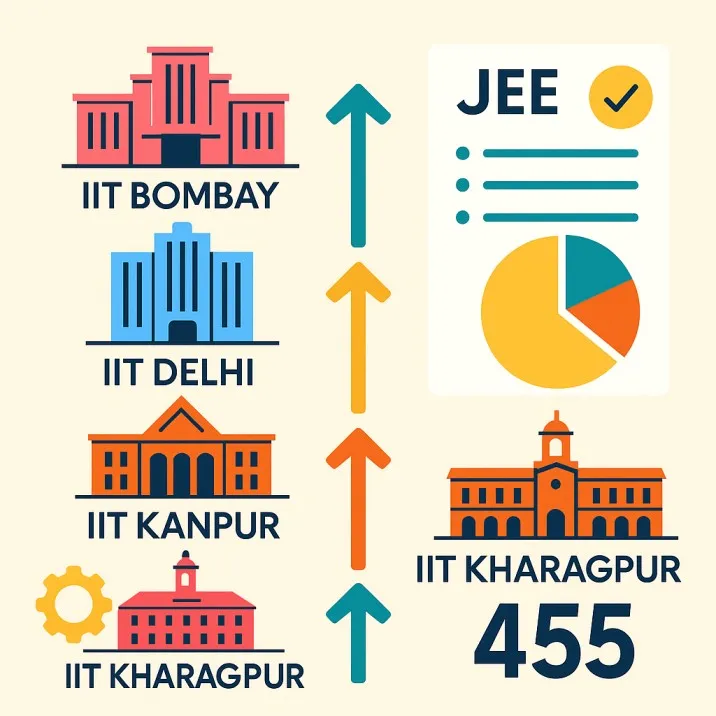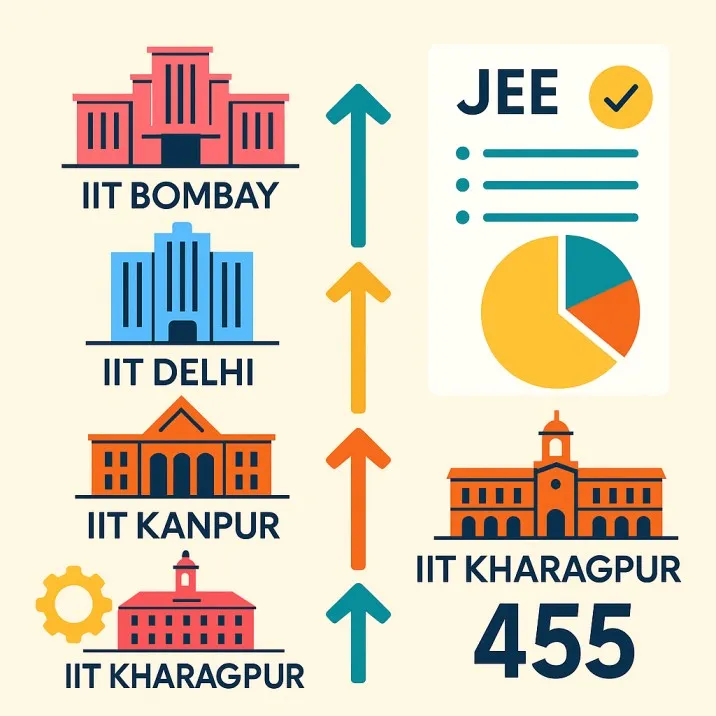

IIT JEE 2025: Rank-vs-IIT Cheat-Sheet to Crack the Top Campuses (Updated with JoSAA 2024 Round-6 data)
1. Why closing ranks matter
JoSAA publishes opening and closing ranks after every counselling round. The last-round closing rank for a branch = the worst All-India Rank (AIR) that still got that seat. Using the toughest branch (Computer Science & Engineering, CSE) shows the true competitiveness of an IIT.
2. Snapshot - last-round CSE ranks, General (Open) quota
|
Rank band |
IIT (CSE) |
|
AIR ≤ 70 |
IIT Bombay - 68 |
|
AIR ≤ 120 |
IIT Delhi - 116 |
|
AIR ≤ 160 |
IIT Madras - 159 |
|
AIR ≤ 260 |
IIT Kanpur - 252 |
|
AIR ≤ 420 |
IIT Kharagpur - 415 |
|
AIR ≤ 500 |
IIT Roorkee - 481 |
|
AIR ≤ 630 |
IIT Guwahati - 623 |
|
AIR ≈ 1 070 |
IIT (BHU) Varanasi - 1 071 |
How to read the table
-
If your target is IIT Delhi CSE, shoot for an AIR ≤ 110 to stay safely above the 2024 cut-off.
-
Ranks drop sharply after CSE; e.g., IIT Bombay Electrical closed at AIR 496.
3. How many marks do those ranks need?
-
2024 JEE Advanced top 70 ranks required ≈ 320 + / 360.
-
AIR 500 hovered near 240-250 marks.
-
Expect a ± 10 % swing depending on 2025 paper difficulty (note the 10 % cut-off dip reported for the tougher 2025 paper).
4. Trend watch (General quota, CSE)
|
IIT |
2022 |
2023 |
2024 |
Direction |
|
Bombay |
61 |
67 |
68 |
Slightly tougher |
|
Delhi |
102 |
118 |
116 |
Fluctuating |
|
Madras |
175 |
148 |
159 |
Mild ease |
|
Kanpur |
237 |
238 |
252 |
Steady climb |
Overall, competition at the very top is creeping upward by 1-3 ranks each year, but mid-tier IITs see wider swings as new specialisations (AI/Data) siphon some demand.
5. What makes cut-offs shift?
-
Seat matrix changes - new gender-neutral seats or extra super-numerary seats.
-
Branch buzz - AI & Data Science stole seats from core CSE at IIT Madras, nudging its CSE rank to 159.
-
Exam difficulty - a tougher paper (like 2025) lowers marks but doesn’t widen top-rank gaps.
-
Category re-allocation - EWS/OBC seats indirectly ease General cut-offs in some rounds.
6. Action plan for JEE 2025 toppers
|
Month |
Focus |
Tactics |
|
Aug - Oct ’24 |
Concept depth |
Finish NCERT + advance to PYQs; zero-error notes |
|
Nov - Jan |
Speed & accuracy |
Weekly full-length tests; target ≥ 70 % score ceiling |
|
Feb - Mar |
Micro-revision |
30-day error log loop; formula flashcards |
|
Apr |
JEE Main safety |
Secure percentile ≥ 99.5 to unlock all centres |
|
May - Exam week |
Peak performance |
Two mock papers/day; simulate exam bell timings |
Pro tip: Keep your effective AIR buffer 10-15 % ahead of the previous year’s closing rank for the IIT/branch you want.
7. FAQs
Will the 2024 ranks repeat in 2025?
Not exactly, but they’re the most reliable baseline until JoSAA releases fresh numbers in July 2025.
What about reserved categories?
Cut-offs drop 2-6× depending on OBC, EWS, SC, ST & female pools (e.g., IIT Delhi CSE OBC closed at 89). Always check category-wise data.
Marks vs rank?
Because rank distribution compresses at the top, a 5-mark slip near 300 can cost 30 ranks, whereas the same drop around 150 marks may cost 300 ranks. Focus on error-free accuracy first.
Key takeaways
-
AIR < 70 keeps IIT Bombay CSE open; AIR < 120 lands IIT Delhi CSE.
-
Mid-400 ranks still fetch CSE at Kharagpur/Roorkee; sub-1 k gets you IIT BHU CSE.
-
Trend lines inch upward each year-build a 10 % safety cushion on 2024 data.
-
Smart time-boxing, error-log cycles & targeted mocks outweigh sheer study hours.
Good luck charting your path to the IIT of your choice in 2025!
FAQs
What is PW Disha?
PW Disha is a one-on-one mentorship platform by Physics Wallah that connects students with mentors for JEE and NEET preparation.
Who are the mentors?
Our mentors are from respected institutes like IITs, NITs, AIIMS, and more. They have cleared the same exams and understand what it takes to succeed—making them ideal mentors for NEET and mentors for IIT JEE.
How do I book a session?
Just fill your details, choose a mentor, pay the session fee, and pick a time slot that fits your schedule—just like any personalized student mentorship program.
What happens in a session?
You get personalized guidance on study planning, time management, doubts, and exam strategies—based on your unique needs, from a NEET guidance program or JEE mentor.
